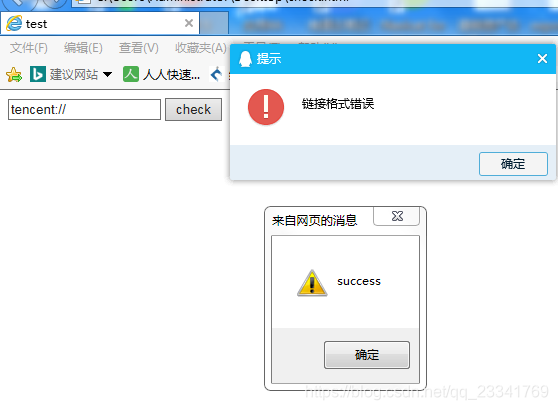最近项目中需要在页面上判断用户电脑上是否安装某个应用程序,类似于手机上浏览器上的通过微信登录,然后页面就会去检测手机是否安装微信app的功能。
例如检测电脑上行是否安装QQ,腾讯的Tencent://Message协议注册表如下:
[HKEY_CLASSES_ROOT\TENCENT] @=”TencentProtocol” “URL Protocol”=”D:\\Program Files\\Tencent\\QQ\\Timwp.exe”
[HKEY_CLASSES_ROOT\TENCENT\DefaultIcon] @=”D:\\Program Files\\Tencent\\QQ\\Timwp.exe,1″
[HKEY_CLASSES_ROOT\TENCENT\shell]
[HKEY_CLASSES_ROOT\TENCENT\shell\open]
[HKEY_CLASSES_ROOT\TENCENT\shell\open\command] @=”\”D:\\Program Files\\Tencent\\QQ\\Timwp.exe\” \”%1\”"
此注册表所实现的就是当浏览器碰到 tencent://… 时,自动调用 Timwp.exe,并把 tencent://… 地址作为第一个参数传递给 Timwp.exe。

提示success则表示已安装。
<!DOCTYPE html PUBLIC "-//W3C//DTD XHTML 1.0 Strict//EN"
"http://www.w3.org/TR/xhtml1/DTD/xhtml1-strict.dtd">
<html xmlns="http://www.w3.org/1999/xhtml">
<head>
<title>test</title>
<meta http-equiv="Content-Type" content="text/html; charset=utf-8" />
</head>
<body>
<iframe id="trigger_protocol_ifrm" style="display:none"></iframe>
<input id="protocolTxt" type="text" value="tencent://" />
<input id="checkBtn" type="button" value="check" />
<script>
document.getElementById('checkBtn').onclick = function(){
var url = document.getElementById('protocolTxt').value;
launchApplication(url, function(){
alert('success');
}, function(){
alert('fail');
});
};
var isDone = true;
var timeout;
var assistEl = document.getElementById('checkBtn');
var triggerEl = document.getElementById('trigger_protocol_ifrm');
function done(){
isDone = true;
assistEl.onblur = null;
triggerEl.onerror = null;
clearTimeout(timeout);
}
function launchApplication(url, success, fail){
if(!isDone)return;
isDone = false;
assistEl.focus();
assistEl.onblur = function(){
if(document.activeElement && document.activeElement !== assistEl){
assistEl.focus();
} else {
done();
success();
}
};
triggerEl.onerror = function(){
done();
fail();
};
try{
triggerEl.src = url;
}catch(e){
done();
fail();
return;
}
timeout = setTimeout(function(){
done();
fail();
}, 3000);
}
</script>
</body>
</html>
参考链接:
https://blog.youkuaiyun.com/zhangyani_502000/article/details/81009907








 本文介绍了一种在网页上检测用户电脑是否安装特定应用程序的方法,如检测QQ安装情况,通过检查注册表项和使用iframe触发协议来判断。文章提供了详细的注册表路径和HTML示例代码。
本文介绍了一种在网页上检测用户电脑是否安装特定应用程序的方法,如检测QQ安装情况,通过检查注册表项和使用iframe触发协议来判断。文章提供了详细的注册表路径和HTML示例代码。
















 1362
1362

 被折叠的 条评论
为什么被折叠?
被折叠的 条评论
为什么被折叠?








